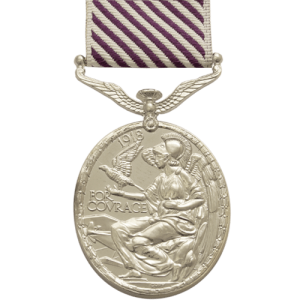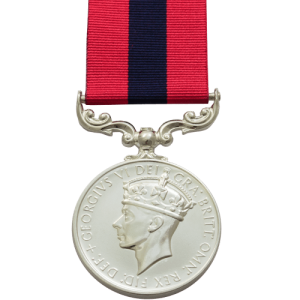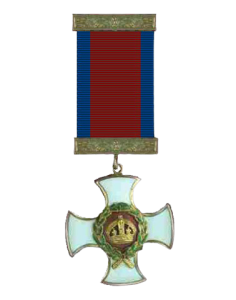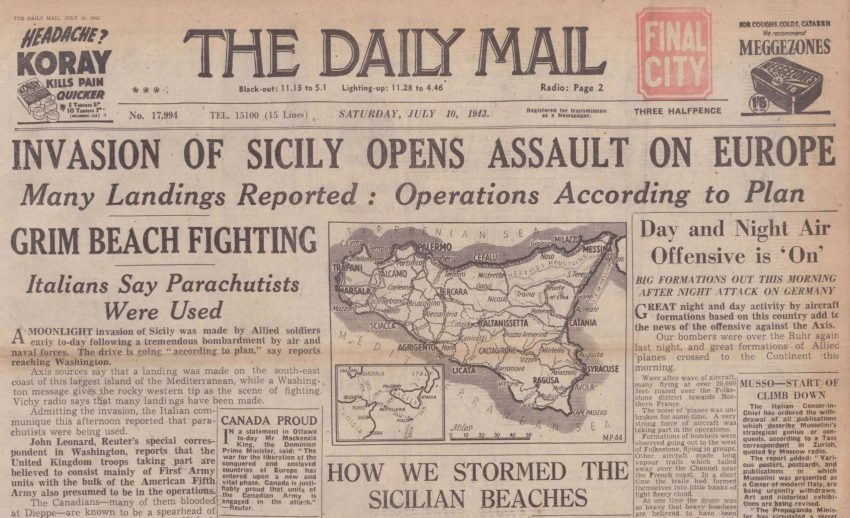On the night of 9/10 July 1943, the Allies launched Operation Husky, the invasion of the Italian island of Sicily.
Operation Husky
Airborne troops landed first by parachute and glider, followed by the amphibious assault on the island. Across three days, 3,000 ships helped to land 150,000 ground troops on the southern shores of Sicily. Over the next five weeks, which also witnessed the fall of Italy’s fascist dictator Benito Mussolini, the Allies continued to push inland in the face of stiff resistance.
The invasion concluded on 17 August 1943, culminating in the large-scale evacuation of German and Italian forces and equipment to mainland Italy via the Straits of Messina. Although the latter bolstered Axis defences in Italy, the invasion dealt them a significant blow; the Allies now had a toe-hold in Axis-occupied Europe, with mainland Italy next in their sights.
We delved into our records and discovered many acts of bravery and heroism during Operation Husky. With so many to choose from, we’ve highlighted a selection below.

Colour Sergeant Dennis Patten Galpin
Distinguished Flying Medal
Criteria: An act or acts of valour, courage or devotion to duty whilst flying in active operations against the enemy.
Recipients: Below commissioned ranks.
The weather on the night of 9/10 July was poor, and the anti-aircraft fire from the defenders on the ground in Sicily was intense. Many gliders crashed into the sea or failed to reach their target. One pilot who did reach his target was Colour Sergeant Dennis Patten Galpin of the Army Air Corps. Galpin was recommended for the Distinguished Flying Medal (DFM) for his actions during Operation Husky, and his citation appears in our DFM collection:
‘This Sergeant Pilot has shown conspicuous gallantry as a glider pilot. He was released at 500 feet over the sea and glided six miles. During this time, he was under fire from anti-aircraft and searchlights. He landed in a field selected by his Commanding Officer. He then took part in the capture of a bridge which led to the capture of Syracuse. It was due to his brilliant landing that the blowing of the bridge was saved, and the operation was successful.’

Serjeant Frederick Joshua Darts
Distinguished Conduct Medal
Criteria: Recognised acts of gallantry carried out by other ranks. Bars were awarded to the medal in recognition of the performance of further acts of gallantry meriting the award.
Recipients: Other ranks
The first wave of Royal Marine Commandos landed in the early hours of 10 July, advancing in the darkness. Deployed ahead of the main force, they paved the way for the Eighth Army landings. Following the landings, Number 3 Commando sailed for the Bay of Agnone, Sicily, on 12 July, tasked with capturing and holding the Malati Bridge near Lentini behind enemy lines.
Serjeant Frederick Joshua Darts served with the Special Service Brigade, Number 3 Commando, during Operation Husky. He was in charge of a section of 3 Commando at Agnone on 13 July 1943:
‘The Beach on which the Commando landed was under heavy fire and casualties were suffered. Sjt. Dart’s section was the last to pass through the wire obstacles set up by the enemy. He realised that to wait according to plan would be disastrous and therefore made a quick personal reconnaissance, discovered another gap and pushing his section through joined up with the Commando at the appointed forming up point. The quick decision undoubtedly saved many lives in his section.
Later in the battle Sjt. Dart gathered what remained of his section and fought a rear guard action with great skill and determination. Time and time again his section inflicted casualties upon the enemy by holding on till the last possible moment in the leapfrog withdrawal action.
Finally the enemy began to close in and one party of German parachutists who had worked round the flank attempted to deceive the Commando rear guard by shouting out the password in English. Sjt. Dart spread out his small force and charged towards the enemy position; in this action 12 of the enemy were killed but many more enemy closed on the flanks and the section were pinned down. Under Sjt. Dart’s inspiring leadership, his men held the enemy off until every round of ammunition had been fired, when they were taken prisoner.’

Major (temporary Lieutenant Colonel) William Anthony ‘Jerry’ Sheil
Bar to the Distinguished Service Order
Criteria: For meritorious or distinguished service by officers of the armed forces during wartime, typically during actual combat against the enemy. A Bar (of plain gold with an imperial crown in the centre) could be additionally awarded as a way of formally recognising further acts of merit and was worn on the medal ribbon.
Recipients: Officers (all ranks since 1993).
Major (Temporary Lieutenant Colonel) William Anthony ‘Jerry’ Sheil served with the Royal Regiment of Artillery during the invasion of Sicily. After landing, Allied forces continued to push inland, capturing objectives as they advanced.
Already a recipient of the Distinguished Service Order (D.S.O.), Sheil was awarded a Bar to his D.S.O. for his actions at Francofonte on 14 July 1943. Sheil was the Commanding Officer of the 128th Field Regiment and Senior Artillery Officer on the spot and was responsible for organising fire support for the attack of 152nd Infantry Brigade:
‘Enemy parachute troops were offering very stubborn resistance, were sniping very accurately and were attempting to regain the initiative. With complete disregard of danger, Col. Sheil went right forward in person to identify the actual centre of resistance which no one else could locate. After a daring reconnaissance he observed the fire of his regiment onto several strong-points and, when this was impossible, himself manhandled [a] 6-pounder and a 17-pounder into action at short range, and then directed their fire. His leadership and inspiring example were a considerable contributing factor to the successful issue of a hard-fought fight.’
Perhaps your ancestor served during Operation Husky or the Italian Campaign of WWII? Try searching for them in our vast world of records – you never know what you might discover.
Cover Image: The Daily Mail, Hull, 10 July 1943, Newspapers.com
Sources
Army Flying Museum, Operation Husky, accessed July 2023.
Combined Operations, Operation Husky – The Invasion of Sicily, accessed July 2023.
Commando Veterans Archive, 3 Commando at Sicily and Malati Bridge, accessed July 2023.
National WWII Museum, Operation Husky: The Allied Invasion of Sicily, accessed July 2023.


